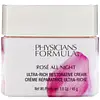What's inside
What's inside
 Key Ingredients
Key Ingredients

 Benefits
Benefits

 Concerns
Concerns

 Ingredients Side-by-side
Ingredients Side-by-side

Water
Skin ConditioningParaffinum Liquidum
EmollientPetrolatum
EmollientRosa Damascena Flower Water
MaskingGlycerin
HumectantLanolin Alcohol
EmollientOzokerite
Emulsion StabilisingPullulan
Leuconostoc/Radish Root Ferment Filtrate
AntimicrobialIsohexadecane
EmollientAcetamidoethoxyethanol
HumectantDecyl Oleate
EmollientMagnesium Sulfate
Parfum
MaskingAvena Sativa Kernel Oil
Skin ConditioningTerminalia Ferdinandiana Seed Oil
AntioxidantTetrahexyldecyl Ascorbate
AntioxidantTocopheryl Acetate
AntioxidantBisabolol
MaskingLeuconostoc Ferment Filtrate
AntimicrobialTripleurospermum Maritimum Extract
Skin ProtectingZingiber Officinale Root Extract
MaskingTetradecyl Aminobutyroylvalylaminobutyric Urea Trifluoroacetate
Skin ConditioningBHT
AntioxidantPhenoxyethanol
PreservativeCaprylyl Glycol
EmollientMagnesium Chloride
Ethylhexylglycerin
Skin ConditioningHexylene Glycol
EmulsifyingCI 17200
Cosmetic ColorantCitric Acid
BufferingWater, Paraffinum Liquidum, Petrolatum, Rosa Damascena Flower Water, Glycerin, Lanolin Alcohol, Ozokerite, Pullulan, Leuconostoc/Radish Root Ferment Filtrate, Isohexadecane, Acetamidoethoxyethanol, Decyl Oleate, Magnesium Sulfate, Parfum, Avena Sativa Kernel Oil, Terminalia Ferdinandiana Seed Oil, Tetrahexyldecyl Ascorbate, Tocopheryl Acetate, Bisabolol, Leuconostoc Ferment Filtrate, Tripleurospermum Maritimum Extract, Zingiber Officinale Root Extract, Tetradecyl Aminobutyroylvalylaminobutyric Urea Trifluoroacetate, BHT, Phenoxyethanol, Caprylyl Glycol, Magnesium Chloride, Ethylhexylglycerin, Hexylene Glycol, CI 17200, Citric Acid
Water
Skin ConditioningSnail Secretion Filtrate
Skin ConditioningGlycerin
Humectant1,2-Hexanediol
Skin ConditioningLimnanthes Alba Seed Oil
Skin ConditioningNiacinamide
SmoothingButylene Glycol
HumectantCetearyl Olivate
Squalane
EmollientPolyglyceryl-3 Methylglucose Distearate
EmulsifyingSorbitan Olivate
EmulsifyingOctyldodecanol
EmollientCetearyl Alcohol
EmollientGlyceryl Stearate
EmollientBeeswax
Emulsion StabilisingDimethicone
EmollientPolyacrylate-13
Palmitic Acid
EmollientStearic Acid
CleansingChlorphenesin
AntimicrobialPhenoxyethanol
PreservativePolyisobutene
Ethylhexylglycerin
Skin ConditioningAdenosine
Skin ConditioningPolysorbate 20
EmulsifyingSorbitan Isostearate
EmulsifyingDisodium EDTA
Betula Alba Juice
AstringentPrunus Amygdalus Dulcis Seed Extract
Skin ConditioningMyristic Acid
CleansingSodium Hyaluronate
HumectantPortulaca Oleracea Extract
Skin ConditioningCopper Tripeptide-1
Skin ConditioningWater, Snail Secretion Filtrate, Glycerin, 1,2-Hexanediol, Limnanthes Alba Seed Oil, Niacinamide, Butylene Glycol, Cetearyl Olivate, Squalane, Polyglyceryl-3 Methylglucose Distearate, Sorbitan Olivate, Octyldodecanol, Cetearyl Alcohol, Glyceryl Stearate, Beeswax, Dimethicone, Polyacrylate-13, Palmitic Acid, Stearic Acid, Chlorphenesin, Phenoxyethanol, Polyisobutene, Ethylhexylglycerin, Adenosine, Polysorbate 20, Sorbitan Isostearate, Disodium EDTA, Betula Alba Juice, Prunus Amygdalus Dulcis Seed Extract, Myristic Acid, Sodium Hyaluronate, Portulaca Oleracea Extract, Copper Tripeptide-1
 Reviews
Reviews

Ingredients Explained
These ingredients are found in both products.
Ingredients higher up in an ingredient list are typically present in a larger amount.
Ethylhexylglycerin (we can't pronounce this either) is commonly used as a preservative and skin softener. It is derived from glyceryl.
You might see Ethylhexylglycerin often paired with other preservatives such as phenoxyethanol. Ethylhexylglycerin has been found to increase the effectiveness of these other preservatives.
Glycerin is already naturally found in your skin. It helps moisturize and protect your skin.
A study from 2016 found glycerin to be more effective as a humectant than AHAs and hyaluronic acid.
As a humectant, it helps the skin stay hydrated by pulling moisture to your skin. The low molecular weight of glycerin allows it to pull moisture into the deeper layers of your skin.
Hydrated skin improves your skin barrier; Your skin barrier helps protect against irritants and bacteria.
Glycerin has also been found to have antimicrobial and antiviral properties. Due to these properties, glycerin is often used in wound and burn treatments.
In cosmetics, glycerin is usually derived from plants such as soybean or palm. However, it can also be sourced from animals, such as tallow or animal fat.
This ingredient is organic, colorless, odorless, and non-toxic.
Glycerin is the name for this ingredient in American English. British English uses Glycerol/Glycerine.
Learn more about GlycerinPhenoxyethanol is a preservative that has germicide, antimicrobial, and aromatic properties. Studies show that phenoxyethanol can prevent microbial growth. By itself, it has a scent that is similar to that of a rose.
It's often used in formulations along with Caprylyl Glycol to preserve the shelf life of products.
Water. It's the most common cosmetic ingredient of all. You'll usually see it at the top of ingredient lists, meaning that it makes up the largest part of the product.
So why is it so popular? Water most often acts as a solvent - this means that it helps dissolve other ingredients into the formulation.
You'll also recognize water as that liquid we all need to stay alive. If you see this, drink a glass of water. Stay hydrated!
Learn more about Water